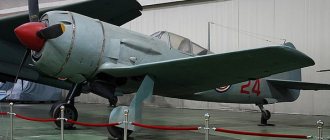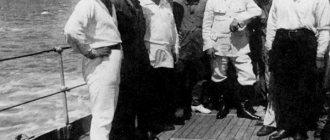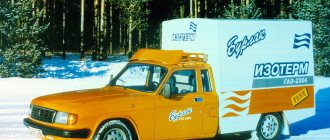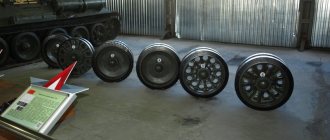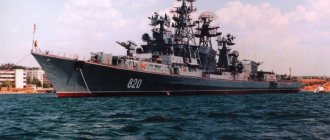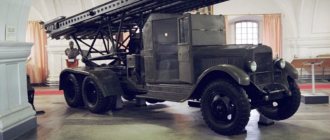| This article requires additional links for verification . |
Armored personnel carrier
| BTR-4 | |
| BTR-4E | |
| Type | Armored personnel carrier |
| Place of origin | Ukraine |
| Service history | |
| In service | 2014-present |
| Used | Iraq Ukraine Indonesia Nigeria Myanmar |
| Wars | Boko Haram insurgency [ citation needed ] International military intervention against ISIS [1] War in Donbass |
| Production history | |
| Designer | Kharkov Mechanical Engineering Design Bureau named after. Morozova |
| Manufacturer | Kharkov Mechanical Engineering Design Bureau named after. Morozova |
| Characteristics | |
| Weight | 17.5 + 3% T (with bulletproof protection) 25 + 3% T (with additional protection) |
| Length | 7.76 m |
| Width | 2.93 m |
| Height | 3.02 m |
| Crew | 3 |
| Armor | Welded steel |
| Engine | Diesel engine 3TD or DEUTZ EURO III 489 hp. or 598 hp |
| Power/weight | 28.6 hp / t (with bulletproof protection) 20 hp. / t (with additional protection) |
| Suspense | wheeled 8×8 |
| Operating range | not less than 690 km |
| Maximum speed | 110 km/h (on road) 10 km/h (on water) |
BTR-4 "Bucephalus"
(Ukrainian: BTR-4 "Bucephalus", romanized: Butsefal, abbreviation Armored Personnel Carrier, Bronetransporter "armored transporter") is an amphibious 8x8 wheeled armored personnel carrier (APC) designed in Ukraine by the Kharkov Morozov Mechanical Engineering Design Bureau (SE KMDB).
They saw action both in the War in Donbass, and the capture of Jurf Al-Nasr from ISIL.
Description[edit]
BTR-4MV1
The BTR-4's layout represents a change from the older BTR-60/70/80 developed in the Soviet Union. The vehicle has a traditional layout, similar to Western designs such as the German TPz Fuchs, with driver and commander compartments in the front of the hull, an engine compartment in the middle and a troop compartment in the rear. Troops enter and exit the vehicle either through the rear doors or through hatches in the roof, and the driver and commander have doors located on the sides of the body.
The BTR-4 has a more flexible design than the older BTR-60/70/80, as the modified layout makes it easier to adapt the vehicle to specialized roles. The car can be armed at the request of the customer. The prototype is armed with a new locally developed weapons module, which is armed with one 30 mm automatic cannon, a 7.62 mm coaxial machine gun, up to four 9P135M Konkurs or Barrier anti-tank missiles (two on each side of the turret) and one 30 mm automatic grenade launcher (installed instead of anti-tank missiles on the left side of the turret). It can also be equipped with various turret weapon modules: the GROM module, the SHKVAL module and the BAU 23x2 module.
The BTR-4 has a maximum speed of 110 km/h and can overcome water obstacles at a speed of 10 km/h. The vehicle is equipped with a 3TD diesel engine with a power of 500 hp. It was reported that he was hit by several shots from a grenade launcher and several shots from small arms without any consequences. [ citation needed
] Slat armor can be fitted for maximum protection against RPG attacks.
Ukrainian state-owned defense manufacturer UkrOboronProm took the opportunity at the Arms and Security exhibition, which runs from October 10 to 13, to unveil a prototype wheeled armored combat vehicle, currently known as the BTR-4MV1. The new BTR-4MV1 is the latest generation of 8x8 armored personnel carriers. BTR-4MV1 is designed in accordance with NATO standards. The vehicle is based on the BTR-4, but with many new improvements. It differs from previous versions primarily in the modified configuration of the vehicle body, which allows the installation of additional types of protection (including ceramic plates and air force) to achieve the fourth and fifth levels of protection in accordance with NATO standards. . In addition, there is a ramp at the rear of the hull, which not only allows soldiers to get in and out of the vehicle faster, but also allows the armored personnel carrier to carry a variety of large cargo, including additional ammunition, spare parts, etc.[ citation needed
]
Armored personnel carrier "Panhard" VCR
Building on the success of its armored vehicles of the AML families and the loading mechanism (4x4), it began developing the ERC armored vehicle (6x6) and the VCR armored personnel carrier (6x6), which have more than 90% of the common chassis elements, such as the engine, transmission, suspension, steering and wheels. The first VCR prototype was shown in 1977, the first batch was released two years later. The VCR is designed specifically for the export market, and is known to be supplied to Argentina, Iraq and the UAE. The VCR has a welded body with a thickness of 8 to 12 mm, the nose of the vehicle is almost identical to the armored personnel carrier mechanism ...
Read more
Service history[edit]
Up to 500 vehicles produced for all operators [ edit
] .
The BTR-4 is assigned to the 1st battalion of the 92nd mechanized brigade of the Ukrainian Armed Forces.
Indonesia
During the Indonesian Marine Corps' initial testing and evaluation, the BTR-4 was successfully tested in Indonesia. [6] [7] In April 2022, it was reported that the Indonesian Marine Corps had prepared a formal letter of withdrawal from any further BTR-4 acquisitions, [8] although, according to Ukroboronprom, the news is part of information warfare and black PR. [9]
Iraq
Iraq has ordered 450 BTR-4s. 40 vehicles from the third delivery batch arrived with rust and damaged bodies and were not accepted by Iraq. [10] [11] [12] [13] [14] [15]
Nigeria
The BTR-4 was delivered to the Nigerian Army in 2014 [ edit
]
Ukraine
Some BTR-4s, which are used by the Ukrainian armed forces in ATO operations, come from a defective batch for the Iraqi army. [16] [17] [18] [19] [20]
Combat use[edit]
Iraq
On 24 October 2014, the Iraqi Army used an APC-4 in the operation to recapture Jurf Al Sahar from ISIS forces, successfully repelling two roadside ambushes. [21]
Ukraine
On June 4, 2014, company representatives reported that the BTR-4E was used in combat operations in the Slavyansk area. Its armor withstood hits from heavy machine guns, anti-theft side screens protected the crew from anti-tank grenade launchers, and armored glass withstood direct hits from sniper rifles. [22] Their original desert camouflage pattern, as seen on Iraqi BTR-4s, can be seen in photographs and videos of ATO operations. [23] Two Ukrainian BTR-4s were captured by pro-Russian separatists in repairable condition. [ citation needed
]
BTR BMR-600
In the early 1970s. The Spanish army issued technical requirements for a wheeled infantry fighting vehicle (6x6), which was subsequently created by ENASA under the name "Pegaso 3,500" (later BMR-600). It was tested together with the Swiss MOWAG Piranha (6x6) and the French Renault VAB (6x6) and was put into service with a total requirement of at least 500 vehicles. The company has created a family of vehicles using the same chassis, namely: the Pegaso 3560/1 armored personnel carrier, the Pegaso 3560/3 self-propelled 81-mm mortar, the Pegaso 120-mm mortar tractor...
Read more
Versions [edit]
The BTR-4 is available in several different configurations.
BTR-4 with Grom module
Transport search and medical vehicle BSEM-4K
Repair and recovery vehicle BREM-4K
- Reconnaissance vehicle BRM-4K,
- Command vehicle BTR-4K,
- Command and staff vehicle BTR-4KSh,
- BTR-4E1 [24]
- The BTR-4MV1 has been modernized to NATO standards with increased protection.
- Fire support vehicle MOP-4K,
- Repair and recovery vehicle BREM-4K and
- Rescue and medical vehicle BSEM-4K.
- BMM-4A - Similar in role to the BMM-1
(BTR-80 family) [vehicle for first aid and evacuation on the battlefield] - BMM-4B - Similar in role to the BMM-2
(BTR-80 family) [battalion-level primary medical care vehicle] - BMM-4C - Similar in role to BMM-3
(BTR-80 family) [field hospital]
Armored personnel carrier "Panhard" MZ
The armored personnel carrier loading mechanism was designed on the initiative, the first batch was released in 1972. The vehicle has 95% of common components with the Panhard AM L armored vehicle, produced in quantities of about 4000, or the South African Sendok-Ostral under license. This allows the buyer country to have a fleet of armored personnel carriers and combat reconnaissance vehicles with the same components, which provides large savings in training and spare parts. More than 25 countries bought the car as...
Read more
Weapon modules [edit]
Standard module:
- Passengers: 3x crew (driver, commander, gunner)
- 8 soldiers (7 soldiers in the reinforced version)
- 1x 30mm automatic cannon
GROM module:
- Passengers: 3x crew (driver, commander, gunner)
- 8x soldier
- 1x 30mm automatic cannon
SHKVAL module:
- Passengers: 3x crew (driver, commander, gunner)
- 8x soldier
- 1x 30mm automatic cannon
Module BAU 23x2:
- Passengers: 3x crew (driver, commander, gunner)
- 8x soldier
- 2x 23x152mm automatic cannons
Command and staff vehicle BTR-4KSh:
- Passengers: 2x crew (driver, vehicle commander)
- 5 staff (commander, four officers)
- 1x machine gun TKB-01-1 caliber 12.7 mm
Fire support vehicle MOP-4K:
- Passengers: 4x crew (driver, commander, gunner, loader)
- 1x 120 mm gun
BTR ASMAT
For more than 25 years, the ASMAT company has been producing 4x4 and 6x6 off-road trucks, characterized by a large range and operational reliability. They are sold to more than 30 countries in Africa, the Middle and Far East. The company also realized that there was a market for armored personnel carriers on the same chassis, and created the 4.20 VSC fuel dispenser, which has now been adopted by many countries. The layout of the 4.20 VSC fuel dispenser is the same as that of a truck: the engine is in front, the commander and driver are in the center, the Troopers sit on benches located ...
Read more
Operators[edit]
BTR-4 operator map
Current operators[edit]
- Indonesia
The Indonesian Marine Corps ordered 5 BTR-UYu with two turreted vehicles OGO-7 "Parus" with a 30 mm ZTM-1 automatic cannon and 3 with 7.62 mm RCWS and began their service in May 2022 [25] Subsequent orders 55 vehicles were canceled due to unsatisfactory performance [ citation needed
], and in April 2022 an order was placed for 21 BT-3F and 22 BMP-3F. [26]
- Iraq
The Iraqi Ministry of Defense ordered 420 vehicles in 2012. [27] Only 88 of the order for 420 were delivered at the end of 2013, and the contract was canceled due to numerous quality failures. According to Ukraine, the contract was renewed, and as of September 2022, Iraq operates 270 vehicles.
- Nigeria
5 BTR-4 for the Nigerian police. [28]
- Ukraine
- Ukrainian Armed Forces - The Ministry of Defense of Ukraine placed an initial order for 10 vehicles, which entered service in 2009. [29] Two BMM-4S were ordered in August 2014 and will be delivered in October 2014. [30] About 170 vehicles are in service as of August 2022. Another 12 vehicles were transferred to the army in October–November 2022. [31] More than 200 vehicles are in service as of January 2022.
- Ministry of Internal Affairs - since March 25, 2014, 10 vehicles have been transferred to the newly recreated National Guard of Ukraine. Until July 2014, 40 cars were delivered to NSU. [32]
- Myanmar - In March 2022, a Ukrainian company and the Myanmar military signed an agreement to create a joint venture to build a plant for the production of armored personnel carriers (APCs) and self-propelled howitzers. are called eight-wheeled BTR-4E. [33]
Possible operators[edit]
- Republic of North Macedonia
The tender for the Republic of North Macedonia Land Forces is for a wheeled infantry vehicle, which is intended to replace the current flotilla of BTR-60 and BTR-70. Estimated order quantities may be up to 200 units. [34]
- Thailand
Royal Thai Marine Corps has reportedly expressed interest in the BTR-4MV1 in October 2022.[35]
BTR "Berlier" VXB-170
After World War II, it was the main supplier of trucks to the French army in the late 1960s. It created a prototype armored personnel carrier, called the BL-12, which used many standard commercial vehicle power components. Further development of this design led to the VXB-170, which was soon adopted by the French Gendarmerie, as well as Gabon and Senegal. In 1975, Berlier merged with the Renault corporation, which by that time had already created prototypes of 4x4 and 6x6 armored personnel carriers. With the acceptance by the army...
Read more
Links[edit]
- "Archival copy". Archived from the original on March 11, 2022. Retrieved 10 March 2022.CS1 maint: archived copy as title (link)
- “BTR-4 wheeled armored personnel carrier of the Ukrainian Army Ukraine description of photographs of equipment | Ukraine Ukrainian Army wheeled armored personnel carrier | Ukrainian army Ukraine military equipment Great Britain". Archived from the original on October 9, 2022.
- "Wheeled armored personnel carrier BTR-4 - Ukraine". Archived from the original on October 9, 2022.
- Information
in: “Report – Wojsko Technika Obronność” Nr. 12/2008, p. 69 (pl icon) - Infodefensa.com (04.10.2009). "Ucrania oferta el BTR-4 como candidate al VBR 8×8 español - Noticias Infodefensa España". Infodefensa.com
(in Spanish). Archived from the original on September 21, 2022. Retrieved September 15, 2022. - "Ukrainian BTR-4M successfully passed tests in Indonesia". www.defense-aerospace.com
. Retrieved January 27, 2022. - Review, Asian Armed Forces (2017-05-26). "Indonesian marines began using Ukrainian BTR-4M". Asian Military Review
. Retrieved January 27, 2022. - The Indonesian Marine Corps is preparing to stop further acquisitions of the BTR-4. Archived September 27, 2022, on the Wayback Machine - Janes.com, April 7, 2022.
- “Indonesia against Ukrainian BTR-4 is a damn fake of the information war.” Ukroboronprom
. 2017-04-11. Retrieved January 27, 2022. - "Iraq accuses Ukraine of selling outdated armored vehicles / Sputnik International". Archived from the original on October 28, 2014. Retrieved November 15, 2014.
- "Iraqi BTR-4s are being sent back to Ukraine". Defense of Pakistan
. Archived from the original on October 28, 2014. Retrieved November 15, 2014. - "Iraq; supply of Ukrainian BTR-4s was rejected." Archived from the original on July 14, 2014. Retrieved November 15, 2014.
- "Good Bad News: 100 APCs for Ukraine". Defense Industry Diary
. April 6, 2014. Archived from the original on October 28, 2014. Retrieved November 15, 2014. - "BTR-4 - military-technical cooperation". Archived from the original on December 18, 2014. Retrieved November 15, 2014.
- "Iraqi BTR-4s are being sent back to Ukraine". Archived from the original on October 28, 2014. Retrieved November 15, 2014.
- "Iraqi BTR-4s are being sent back to Ukraine". Defense of Pakistan
. Archived from the original on October 28, 2014. Retrieved November 15, 2014. - "Iraq; supply of Ukrainian BTR-4s was rejected." Archived from the original on July 14, 2014. Retrieved November 15, 2014.
- "Good Bad News: 100 APCs for Ukraine". Defense Industry Diary
. April 6, 2014. Archived from the original on October 28, 2014. Retrieved November 15, 2014. - "BTR-4 - military-technical cooperation". Archived from the original on December 18, 2014. Retrieved November 15, 2014.
- "Iraqi BTR-4s are being sent back to Ukraine". Archived from the original on October 28, 2014. Retrieved November 15, 2014.
- ↑
Al Salami, Jassem.
"Led by an armored bulldozer, Shiite militia fought to restore their authority". War is boring
. Medium.com. Archived from the original on December 19, 2014. Retrieved November 26, 2014. - ↑
Ukrainian armored personnel carrier BTR-4 8x8, used during the anti-terrorist operation in Slavyansk. Archived January 14, 2015, on the Wayback Machine - Armyrecognition.com, June 5, 2014. - "The National Guard of Ukraine will receive BTR-4". Archived from the original on October 28, 2014. Retrieved November 15, 2014.
- ↑
The Kharkov Machine Design Bureau has developed a new version of the BTR-4 with additional protection. Archived March 13, 2014, at the Wayback Machine. Military panorama. March 12, 2014 - Spetstechnoexport of Ukraine has signed a contract for the supply of 5 armored BTR-4 8x8 to Indonesia. Archived May 13, 2016, on the Wayback Machine - Armyrecognition.com, January 24, 2014.
- "Indonesia buys BT-3F and BMP-3F armored vehicles from Russia". Archived from the original on April 25, 2022. Retrieved April 28, 2022.
- "Ukraine, Iraq in $2.5 billion arms deal". defenseindustrydaily.com. 2012-10-10. Archived from the original on July 7, 2014. Retrieved May 25, 2014.
- Guy Martin. "Nigeria's Recent Military Procurements". Archived from the original on April 7, 2015. Retrieved March 30, 2015.
- "News feed: ALL.BIZ: Ukraine". Ua.all-biz.info. Archived from the original on 2013-01-08. Retrieved May 25, 2014.
- Ukroboronprom will deliver the first armored ambulances based on the BTR-4E to the military by October. Archived on June 10, 2015 on the Wayback Machine // "UNIAN" dated August 15, 2014
- The Ukrainian army received the first BTR-4 armored personnel carriers made of new Ukrainian armored steel (photo). Archived October 30, 2022 on the Wayback Machine, UNIAN (October 30, 2022)
- » Previously, the state purchased 40 new BTR-4 armored personnel carriers in Kharkov for the needs of the National Guard.
» The National Guard received five new BTR-3E armored personnel carriers from the Kiev Armored Plant - media. Archived on October 11, 2014 in the Wayback Machine // "UNIAN" dated June 25, 2014 - "Joint venture to supply Ukrainian armored personnel carriers to the Myanmar army".
- "Kyiv Post. Independence. Community. Trust - Ukraine - Macedonia" became interested in "advanced light armored vehicles of Ukraine". 2011-08-05. Archived from the original on 2011-08-05. Retrieved September 15, 2022.
- Grevatt, John (12 October 2018). “Thailand is interested in a new version of the BTR-4,” reports the Ukrainian agency.” IHS Jane 360
. Bangkok. Archived from the original on October 12, 2022. Retrieved October 12, 2022.
BMP "Ratel 20"
For many years the standard vehicle of this type in the South African Army was the British Elvis Saracen armored personnel carrier. When it became obvious that the future supply of machines and spare parts for them became doubtful, the South Africans decided to create a new machine to meet their needs. Then, as now, it produced a modified version of the Panhard AML 4x4 light armored vehicle for the South African army, under the name "Eland", and the task of creating a new vehicle was assigned to this...
Read more
BTR TM 170
from Witten-Annen has developed three light wheeled armored personnel carriers using its own funds, using existing proven components to reduce the cost of purchasing and operating the vehicle to an absolute minimum. These are the TM 170, TM 125 and TM 90. The largest member of the family, the TM 170, has a crew of two and can carry 10 fully armed soldiers, although the vehicle is most often used by internal security forces to quickly and safely transport police contingents to their place of employment . ...
Read more
BTR-152
During World War II, the Soviet Union did not use amphibious or wheeled armored personnel carriers. The BTR-152 armored personnel carrier was first shown in 1951, but was probably put into service several years earlier. The vehicle consists of a ZIL-151 truck chassis, with a fully armored body; the latest series of vehicles, starting with the A-152V1 armored personnel carrier, had the chassis of an improved ZIL-157 truck. Since the early 1960s. it was replaced in Soviet motorized infantry divisions by an armored personnel carrier of the Armored Personnel Carrier-60 series, which has better maneuverability. ...
Read more
Notes
- ↑ The Military Balance 2016, p.206
- ↑ The Military Balance 2016, p.332
- ↑ (inaccessible link). Retrieved April 9, 2016.
- ↑ The Military Balance 2016, p.461
- ↑ The Military Balance 2022, p.269
- ↑
- Vitchiznyany armored personnel carrier // “World of Ukraine”, No. 11-12 (147) 2012. p.16
- Ukraine // “Foreign Military Review”, No. 12 (813) 2014, p. 109
- Sergey Zgurets. Debut of the strong-minded // Defense Express magazine, No. 1-2, 2013. pp. 26-31
- ↑. fkoz.feodosia.com.ua. Retrieved September 28, 2015.
- . Business newspaper “Vzglyad” (June 1, 2016). Retrieved September 4, 2016.
- Olga Samofalova.
. Business newspaper “Vzglyad” (February 27, 2015). Retrieved September 4, 2016.
- . yablor.ru. Retrieved September 28, 2015.
- . fkoz.feodosia.com.ua. Retrieved September 28, 2015.
- ↑
- ↑
- ↑ M. Baryatinsky.
. Military-industrial courier No. 34 (451) (August 29, 2012). Retrieved October 15, 2015.
- Anatoly Tsyganok.
. Military-industrial courier No. 22 (588) (June 17, 2015). Retrieved September 4, 2016.
- Igor Kataev.
. Military-industrial courier No. 48 (465) (December 5, 2012). Retrieved September 5, 2016.
- (unavailable link). Retrieved April 8, 2016.
- The Military Balance 2016, p.491
Firepower of the vehicle
The new armored personnel carrier certainly did not disappoint in this regard. Thus, the designers have developed specifically for it a mass of remote-controlled combat modules, which seriously increase the firepower of light armored vehicles. Especially worth mentioning are the Grad and Parus, BAU-32, as well as numerous foreign-made variants that can be installed at any time on equipment such as the BTR-4 Bucephalus. Photos of these options are partially available in this article.
It should be noted that all fire modules can be controlled (remotely) not only by the shooter, but also by the vehicle commander. Observation of the enemy and aiming can be carried out using both standard optical systems and powerful electronic systems that are capable of effectively performing their task at night and in conditions of poor visibility.
In addition, the crew can focus on the image that will be received from a circular camera mounted on the armor. The picture is transmitted to a monitor located in front of the commander’s workplace.
A separate observation module “Panorama-2P” is also designed for the latter, which provides the most expanded and detailed picture of the combat situation around such a vehicle as the BTR-4E “Bucephalus”. The photos don't do it justice, but the view from the commander's seat is really excellent.
BTR "Condor"
Building on the success of the UR-416 armored personnel carrier, I decided to create a new vehicle with improved armor protection, greater speed, range and payload capacity, amphibiousness, and capable of carrying heavier weapons installations. The first prototype of the car, called the Condor, was ready in 1978, and soon the first batch was sold to Uruguay. In 1981, Malaysia gave its largest order of armored vehicles - 459 units and 186 SIB-MAS (6x8) vehicles - to Belgium. "Condor" has a welded steel body, ...
Read more
BTR "Transportpanzer 1"
In the mid-1960s. the West German army decided to create a new family of vehicles using common components; it includes 4x4, 6x6 and 8x8 trucks, an 8x8 armored reconnaissance vehicle and a 4x4 and 6x6 armored personnel carrier. The 8x8 reconnaissance armored vehicle subsequently became known as the Lux, in 1975-1978. 408 of them were produced. Ultimately, only the 6x6 armored personnel carrier under the name “Transportpanzer 1” went into production. In 1977, it received a contract for the production of 996 machines, the first of which was manufactured ...
Read more
BTR PSZH-IV
In the 1960s Hungary created the FUG (4x4) amphibious reconnaissance armored vehicle, which it used instead of the Soviet BRDM vehicle. Further development of this design led to a machine shown for the first time in the mid-1960s. and named FUG-66 or FUG-70. At first it was thought that it should replace the first version of the FUG in the role performed by the Soviet amphibious reconnaissance vehicle BRDM-2. However, it later turned out that the new vehicle is called PSZH-IV and serves as an armored personnel carrier, not a reconnaissance vehicle. The PSZH-IV body is all-welded from steel...
Read more

